This section contains entries about our botanizing in Baja California written for the UC BEE (Oct 2012 to Aug 2021)
and The UC Hive (2022-), monthly newsletters for volunteers and staff of the UC Berkeley Botanical Garden.
Click on any photo for a larger image.
BEE MAR 2020
The Vizcaíno Desert Superbloom — Late January 2020

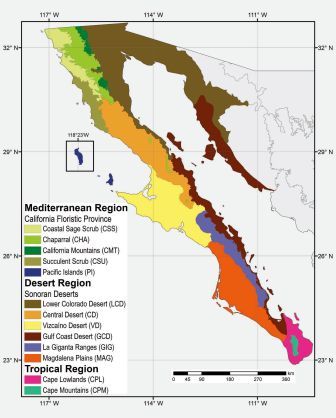 In late January we headed north towards the border. On route we passed through five of Baja California’s 13 ecoregions: the Central Gulf Coast and the north edge of the Sierra de la Giganta as well as the Vizcaíno, Central and Lower Colorado Desert ecoregions. We crossed through the latter three ecoregions in just one day. And what a difference just 8 to 10 days can make! Our return trip was much more colorful. The scenery was spectacular and the abundance of plants so overwhelming that I ended up with too many photos for just one BEE entry. I will cover the Vizcaíno Desert and the tiny part of the Sierra de la Giganta region this month, and the latter three desert regions next month.
In late January we headed north towards the border. On route we passed through five of Baja California’s 13 ecoregions: the Central Gulf Coast and the north edge of the Sierra de la Giganta as well as the Vizcaíno, Central and Lower Colorado Desert ecoregions. We crossed through the latter three ecoregions in just one day. And what a difference just 8 to 10 days can make! Our return trip was much more colorful. The scenery was spectacular and the abundance of plants so overwhelming that I ended up with too many photos for just one BEE entry. I will cover the Vizcaíno Desert and the tiny part of the Sierra de la Giganta region this month, and the latter three desert regions next month.
Sierra de la Giganta and the Vizcaíno Desert
From Santa Rosalía, the highway climbs up the steep grade known as the Cuesta del Infierno (Hell's Grade), peaking at about 395 m (1296 ft) a few kilometers past the steepest part of the ascent. A second grade near el Volcán de las Tres Vírgenes reaches 500 m (1640 ft). Along this stretch of about 20 km between the two grades, the road skirts around and passes through the northern limits of the Sierra de la Giganta. It then begins a gradual westward descent into the Vizcaíno Desert region, passes through San Ignacio, then takes a turn north, continuing along a wide, mostly sandy-silty plain interrupted occasionally by sand dunes and volcanic outcrops or overlain with ancient lava flows. The shrubs and trees were very green, especially on the north-facing slopes, and wildflowers were springing up.
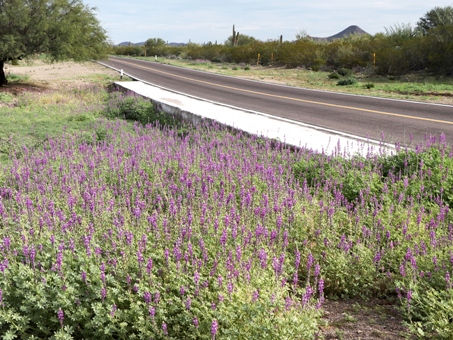
Once up the Cuesta del Infierno northwest of Santa Rosalía, the Arizona Lupine (Lupinus arizonicus, Fabaceae) started to show up along the highway. In this particular area, which extends from about Km 30 to Km 70 (elevation from 370 to 500 m), wonderful winter displays of this native perennial are common. This was an especially good year because of the ample late rain.
The Vizcaíno Desert
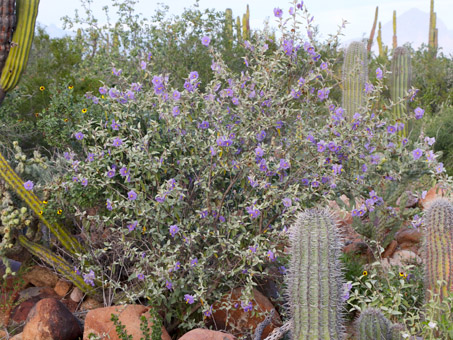
North of San Ignacio, starting around Km 90, we started to see lots of purple: the flowers of Baja California Nightshade / Mariola (Solanum hindsianum, Solanaceae). This native shrub is abundant in disturbed areas, like the edges of the highway. It is common, but less abundant, in undisturbed desert habitats.
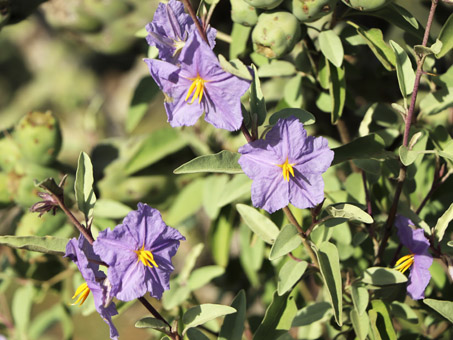
The flowers are varied in color, ranging from a pale lavender to a dark purple. The green leaves on this plant are evidence of having had ample water. Besides the occasional rain, water along this stretch comes in the form of coastal fog. At the beginning of this trip on the more arid Gulf coast, this species had very gray-green leaves.
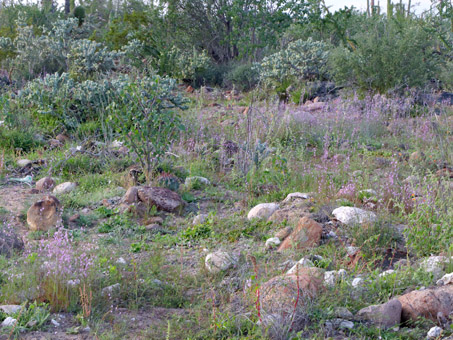
Another purple flower caught our attention along with the nightshade: Angel Rock-Cress (Sibara angelorum, Brassicaceae). Small stands of this delicate annual were interspersed here and there for about 15 km south of the turnoff to Punta Abreojos (Km 95-110).
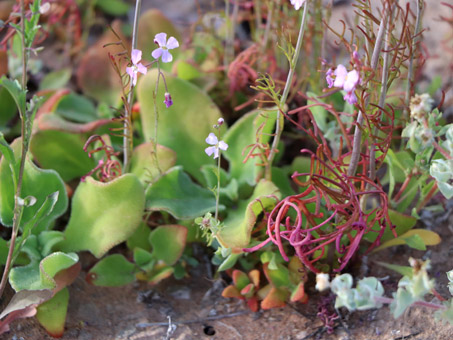
The petals are pale to dark pink and when en masse, are quite eye-catching. The leaves are thready and deeply cleft. Here the fading leaves are red & appear tangled. The plant can stand to 50-80 cm H. The plants were seen for only a few km before disappearing.
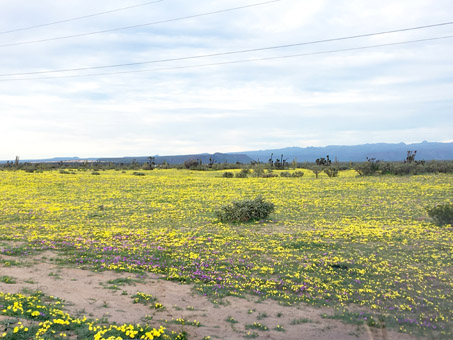
Farther north, around Km 75, near the turnoff to the Sierra de San Francisco. Vizcaíno Sun Cups (Eulobus sceptrostigma, Onagraceae) carpet the ground, with a few Slender Sand Verbena (Abronia gracilis, Nyctaginaceae) here and there.

Another hour north, on the sandy plains around the town of Guerrero Negro, new vegetation was spotty: many places were quite bare while others a short distance away were dense with young sprouts. Here, a few Baja California Sun cups (Eulobus angelorum) were in bloom.
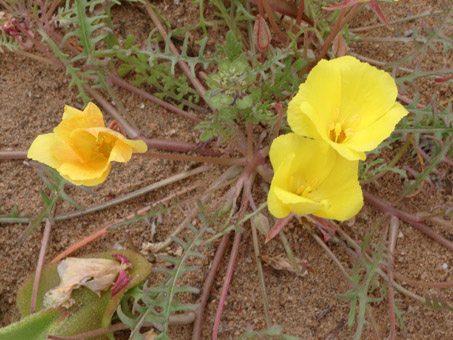
Vizcaíno Sun Cup (Eulobus sceptrostigma, Onagraceae).

Slender Sand Verbena / Alfombrilla (Abronia gracilis, Nyctaginaceae).

Dune Milkvetch / Garbancillo, a peninsular endemic (Astragalus magdalenae var. magdalenae, Fabaceae).
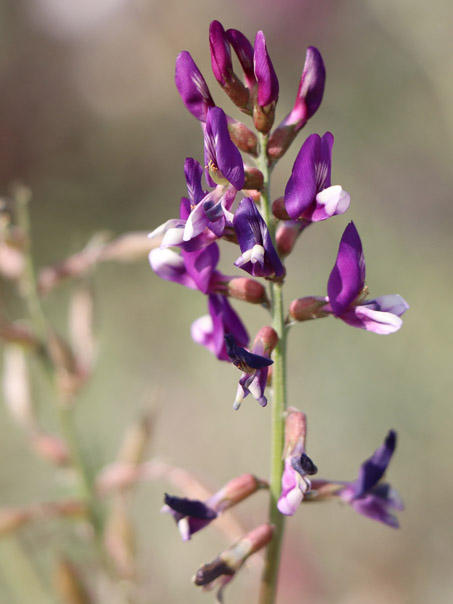
While common on dunes, in the Vizcaíno desert, Dune Milkvetch is also abundant along the highway edge.
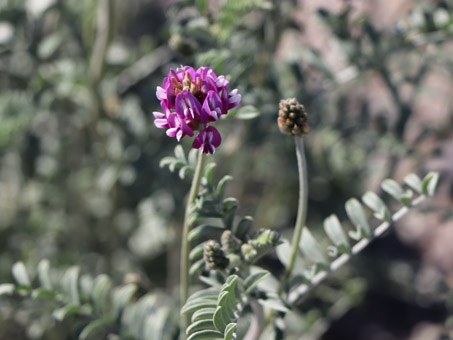
Dune Milkvetch (Astragalus magdalenae var. magdalenae).
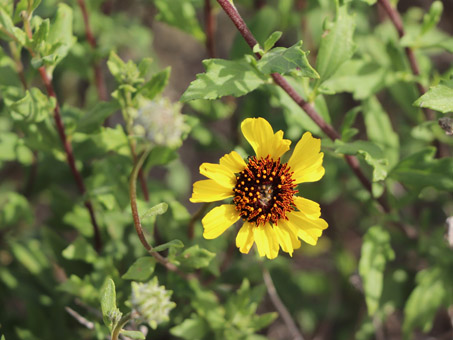
Brittlebush hybrid (Encelia sp., Asteraceae). Likely a hybrid of E. palmeri and E. ventorum, both parents present nearby in the dunes.
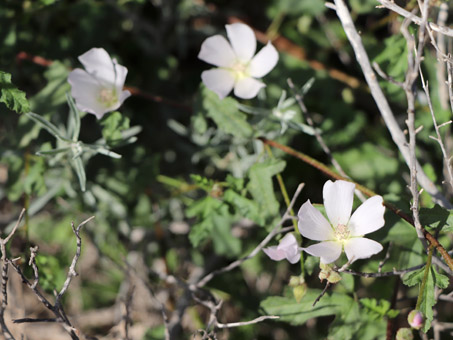
San Quintín Globemallow (Sphaeralcea fulva, Malvaceae) is an endemic shrub, found mostly along the coast from just S of Ensenada, BC to the northern part of the Vizcaíno peninsula & adjacent Pacific islands.
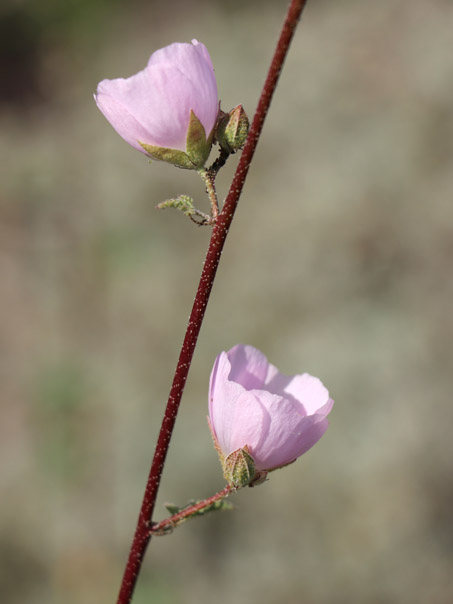
The pale pink petals of San Quintín Globemallow are c. 2 cm L; the stems are often maroon or reddish-brown with sparse stellate hairs. The plant is commonly cespitose, reaching to about 1 m H.
About 20-25 kilometers north of Guerrero Negro just past Villa Jeús María, there were even fewer flowers but it was incredibly green. However, up close we could see the sprouts of a lots and lots of native annual species covering the ground, and one particular surprise, Desert Rhubarb.
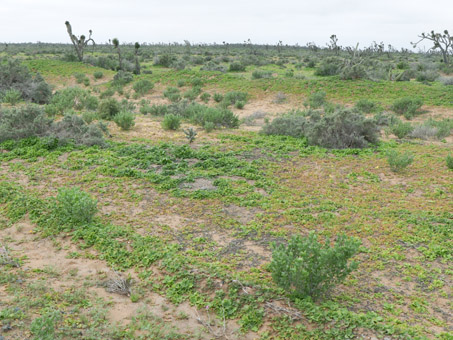
Most of the green groundcover in the foreground is Crystalline iceplant/ Hielitos (Mesembryanthemum crystallinum, Aizoaceae), a non-native, invasive annual.
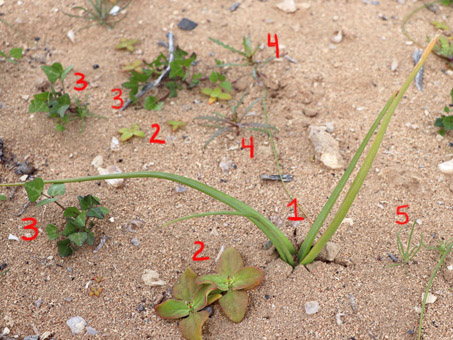
1. Blue Sand-lily, a bulb (Triteleiopsis palmeri, Themidaceae); 2. Crystalline iceplant; 3. Slim-Jim Bean / Frijolito (Phaseolus filiformis, Fabaceae); 4. Baja California Sun Cups; and 5. Cryptantha (Johnstonella sp., Boraginaceae).
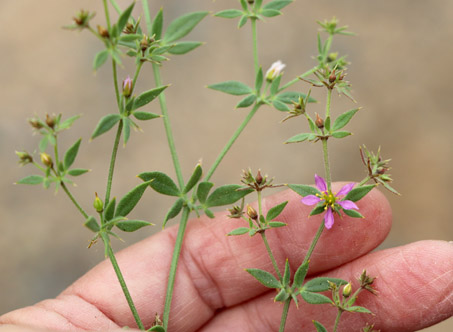
Fagonbush (Fagonia sp., Zygophyllaceae). The stipules are prickly. Flowers are about 1 cm D. Presence of fruit would help with ID.
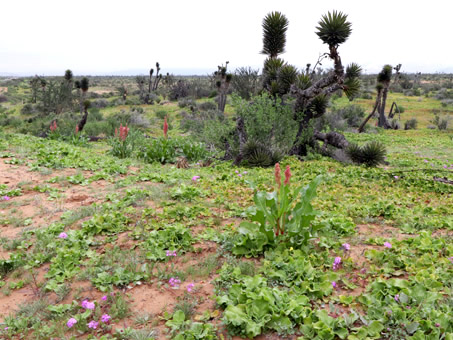
Desert Rhubarb / Hierba Colorada (Rumex hymenosepala, Polygonaceae). North of Villa Jesús María it was conspicuously abundant on the sand dunes on both sides of the highway.
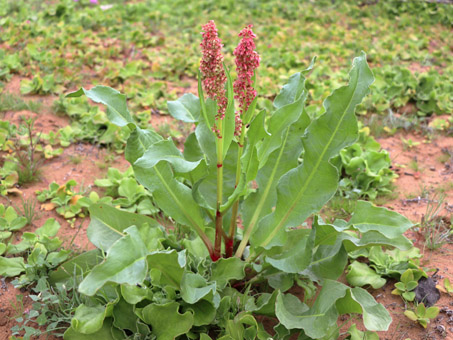
Desert Rhubarb (Rumex hymenosepala). The plants were about 60-80 cm H, the leaves long and broad.
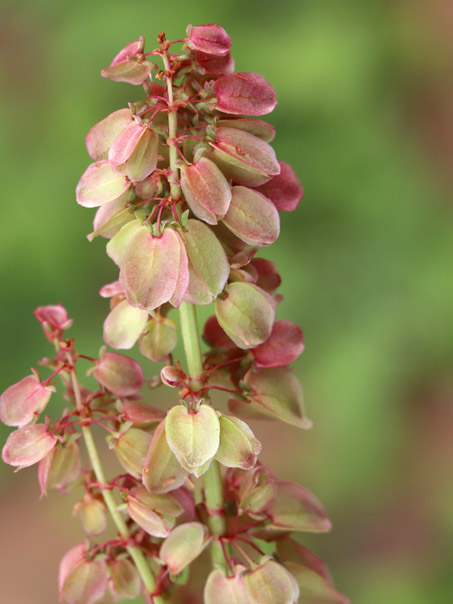
Just a few branches of the showy
inflorescence of Desert Rhubarb.
Vizcaíno Redux: 8-10 days later
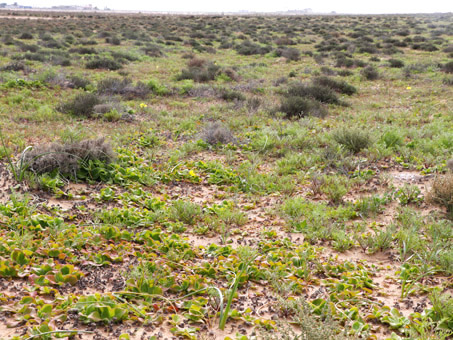
It looked like this near Guerrero Negro when we went north...
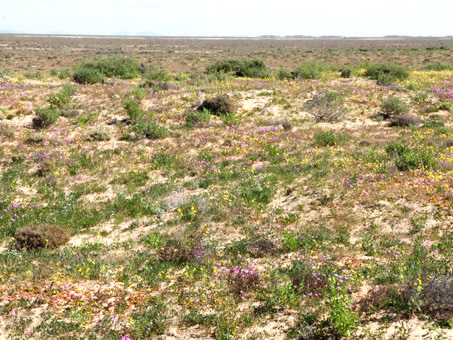
...and this when we came back. Still foggy and gray!
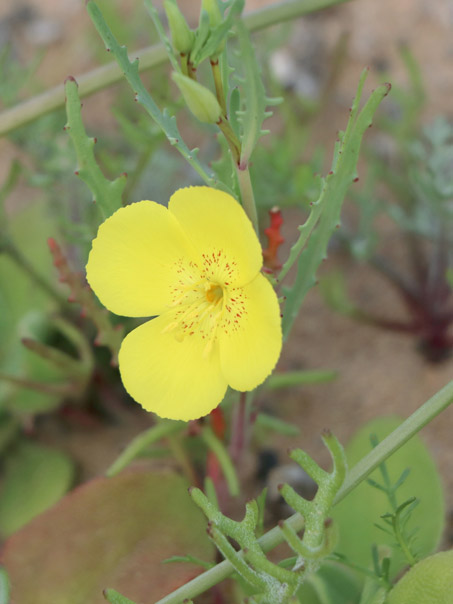
Baja California Sun Cup (Eulobus angelorum) was seen mostly within about 10-15 km north and south of Guerrero Negro. The growth habit of this annual is open and ascending. It can reach about 70-80 cm H. Petals have a few orange spots near their base.
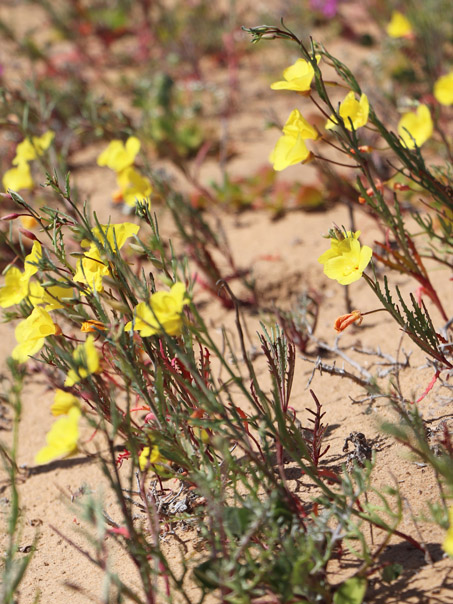
E. angelorum on a west facing dune have all turned toward the afternoon sun. The Sun Cup flowers track the sun throughout the day. This species is endemic to the peninsula and ranges as far north as Bahía San Luís Gonzaga on the Gulf coast.
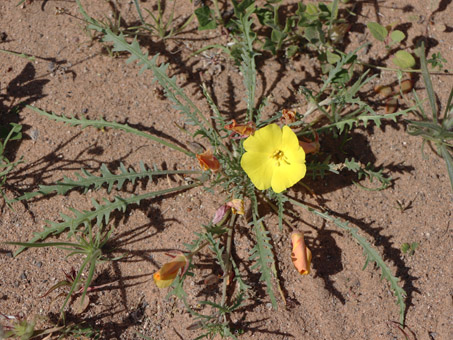
By contrast, Vizcaíno Sun Cup (Eulobus sceptrostigma) has a prostrate growth habit from a basal rosette. It was seen mainly north & south of Villa Jesús María (located 20 km N of Guerrero Negro), as well as farther south, all around the town of Vizcaíno. It too is a peninsular endemic. The stigma is club-shaped while that of E. angelorum is globose.
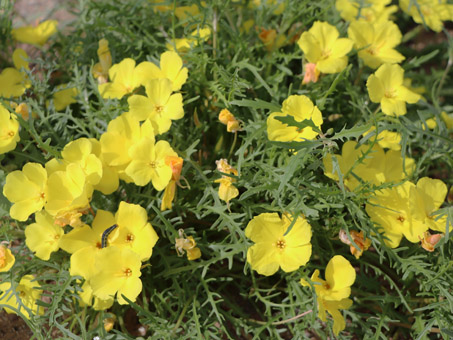
The two Sun Cups seem to have different habitat preferences. Eulobus angelorum seems to prefer the open sand dune areas, while E. sceptrostigma, seems to prefer sandy-silty soils, gravelly roadsides, and more rocky, volcanic soils, such as those S of Vizcaíno.

Seaside Calandrinia (Cisthanthe maritima, Montiaceae) is an uncommon succulent. This specimen was about 10 cm W.
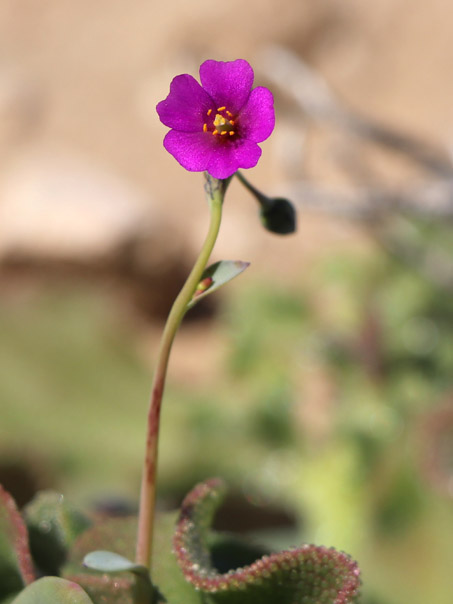
Seaside Calandrinia. The flower is about 5 mm D.
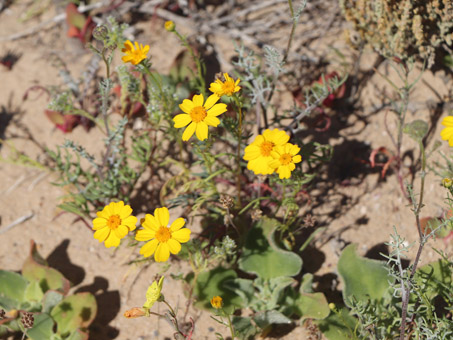
Peninsular Dyssodia / Hediondilla (Boeberastrum anthemidifolia, Asteraceae). For some of us with discerning noses, this annual lives up to its Spanish name: little stinker.
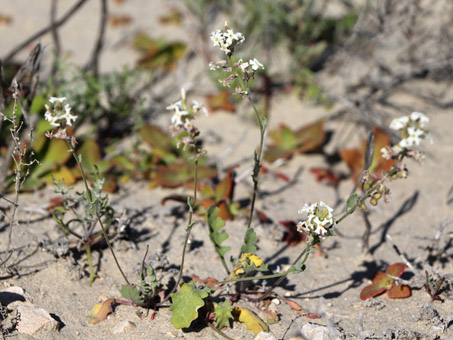
This was a great season for California Spectacle Pod (Dithyrea californica, Brassicaceae) across the area.
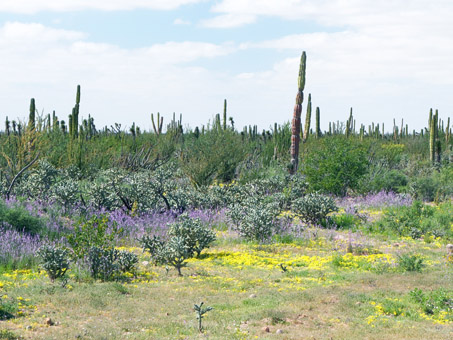
Just a few miles south of the town of Vizcaíno, we saw this first eye-catching patch of Angel Rock-Cress (Sibara angelorum, Brassicaceae).
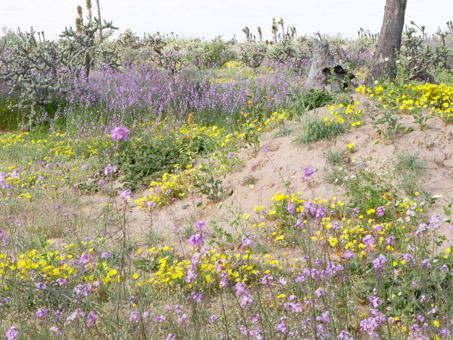
It was spectacular and only the beginning of almost 50 km of intermittent displays just off the highway margins mostly in the scrub.
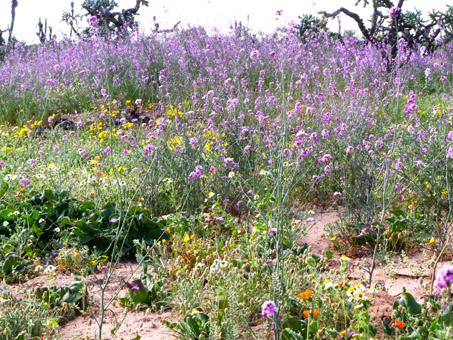
Angel Rock-Cress (Sibara angelorum). Sun cups, Orange Globemallow (Sphaeralcea ambigua Malvaceae), Iceplant.
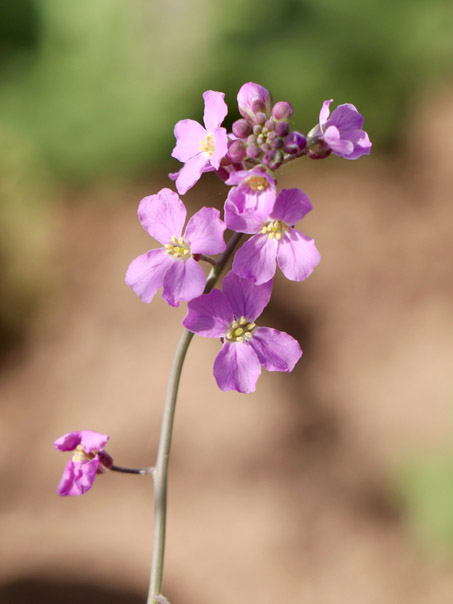
Flowers of Angel Rock-cress, about 5-8 mm D. The
fruit is a slender, reflexed silique c. 15-50 mm L.
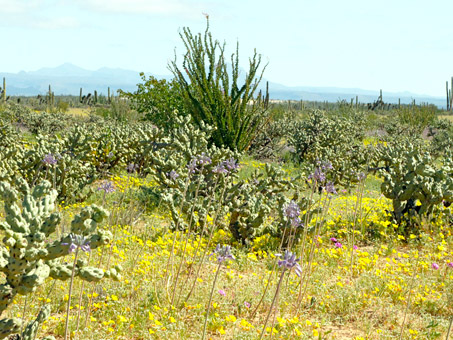
Blue Sand-lily (Triteleiopsis palmeri, Themidaceae) by the hundreds along with Vizcaíno Sun Cup.
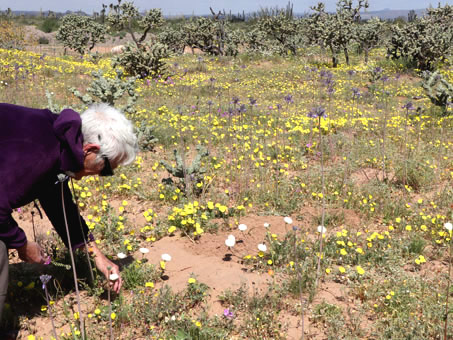
Blue Sand-lilies, Desert dandelion (Malacothrix glabrata, Asteraceae), & Vizcaíno Sun Cup.

Bug's perspective of Blue Sand-lily and Vizcaíno Sun Cups. There were more lilies that hadn't flowered yet than ones already in bloom.
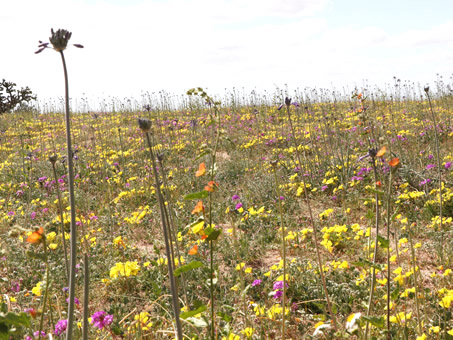
OK, more than hundreds...let's says thousands & thousands of Blue Sand-Lilies...intermittently for at least 100 km along the highway!
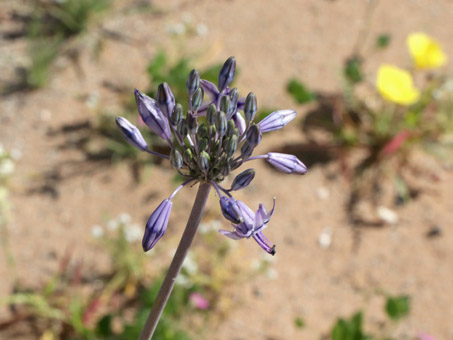
Blue Sand-Lily (Triteleiopsis palmeri), is a common native perennial herb that arises from a corm. The inflorescence is c. 8-10 cm D.
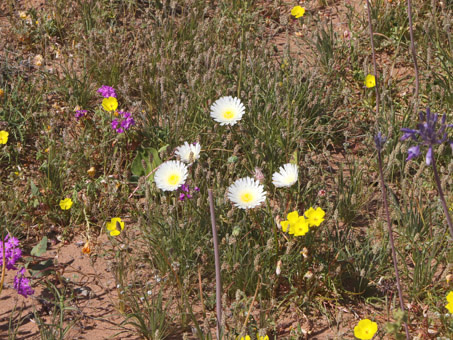
Desert Dandelion (white, Malacothrix glabrata). This native species reaches to about 20 cm H.

Slender Sand Verbena (Abronia gracilis), Eulobus angelorum, & iceplant.
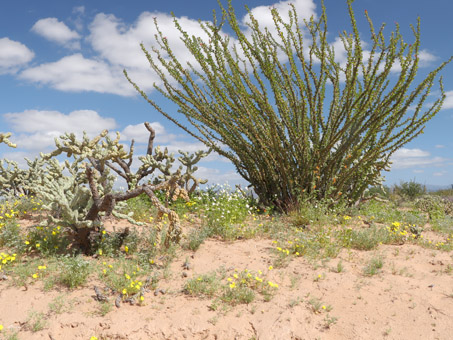
Palo Adán (Fouquieria diguetii, Fouquieriaceae) with lush foliage. Suncups & Cryptanthas (Johnstonella spp, Boraginaceae), along with the ubiquitous endemic Chain-link Cholla / Cholla Pelona (Cylindropuntia cholla).

The Sierra San Francisco provide a backdrop to the carpet of Sun Cups, Sand Verbena and Desert Rock-Cress.
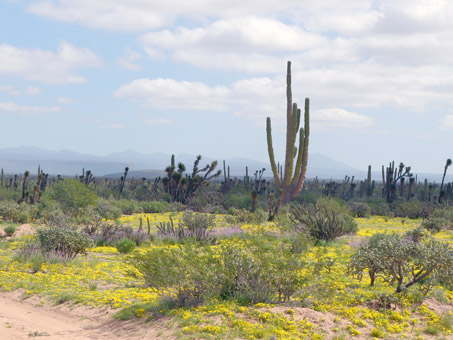
Another view of the Sierra San Francisco.
What an amazing trip. Heading for home, with each kilometer we thought it couldn't get any more colorful, only to be treated a few minutes later to another view even more spectacular than the previous one. Normally a three and a half hour trip back to Mulegé, we took all day as we stopped to look, explore and photograph. We certainly hadn't expected a superbloom when we set our itinerary back in November. Next month, I'll cover the other part of our trip through the Central and Lower Colorado deserts. Until then, hasta la próxima…
Debra Valov—Curatorial Volunteer
References
Rebman, J. P., J. Gibson, and K. Rich, 2016. Annotated checklist of the vascular plants of Baja California, Mexico. Proceedings of the San Diego Society of Natural History, No. 45, 15 November 2016. San Diego Natural History Museum, San Diego, CA. Full text available online.
Rebman, J. P and Roberts, N. C. (2012). Baja California Plant Field Guide. San Diego, CA: Sunbelt Publications. Descriptions and distribution.
Wiggins, I. L. (1980). The Flora of Baja California. Stanford University Press. Keys and descriptions.

















































